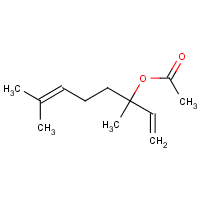Linalyl acetate
Agent Name
Linalyl acetate
CAS Number
115-95-7
Formula
C12-H20-O2
Major Category
Biological Agents

Synonyms
1,6-Octadien-3-ol, 3,7-dimethyl-, acetate; 3,7-Dimethyl-1,6-octadien-3-ol acetate; 3,7-Dimethyl-1,6-octadien-3-yl acetate; Acetic acid linalool ester; Bergamiol; Bergamol; Bergamot mint oil; Ex bois de rose (synthetic); Licareol acetate; Linalol acetate; Linalool acetate; Linalyl acetate (natural); Lynalyl acetate; [ChemIDplus]
Category
Plant Oils and Extracts
Description
Clear colorless liquid with an odor of bergamot; [Hawley]
Sources/Uses
Present in bergamot, lavender, and other volatile oils; [Merck Index] Used in perfumes, soaps, cleaning products, cosmetics, oil paints, and flavoring extracts; [HSDB]
Comments
Emergency treatment: "Linalool"; [HSDB] Included in list of "established contact allergens in humans"; [EC: Scientific Committee on Consumer Safety: Fragrance allergens in cosmetic products (2011)] Causes somnolence and ataxia and acts as a general anesthetic in lethal dose studies of rats; [RTECS] Safe when used as a flavoring agent in food; [JECFA] Hydrolyzed in the GI tract into linalool and acetic acid; Not a mutagen; Not likely to be a sensitizer; Linalool, a hydrolysis product, caused "hepatocellular cytoplasmic vacuolisation" in 28-day feeding studies of rats; [Reference #1] See "Linalool."
Reference Link #1
Biomedical References
Exposure Assessment
Vapor Pressure
0.111 mm Hg
Odor Threshold Low
6.06 ppm
Lethal Concentration
LC50 (mice) > 1,028 mg/m3/4h
Explanatory Notes
Odor threshold from CHEMINFO;
Reference Link #2
NFPA
high ambient temp required
Adverse Effects
Skin Sensitizer
Yes
Neurotoxin
Acute solvent syndrome
Hepatotoxin
Hepatoxic (a) from occupational exposure (secondary effect) or (b) in animal studies or in humans after ingestion
Diseases, Processes, and Activities Linked to This Agent
Diseases
Occupational diseases associated with exposure to this agent:
Processes
Industrial Processes with risk of exposure: